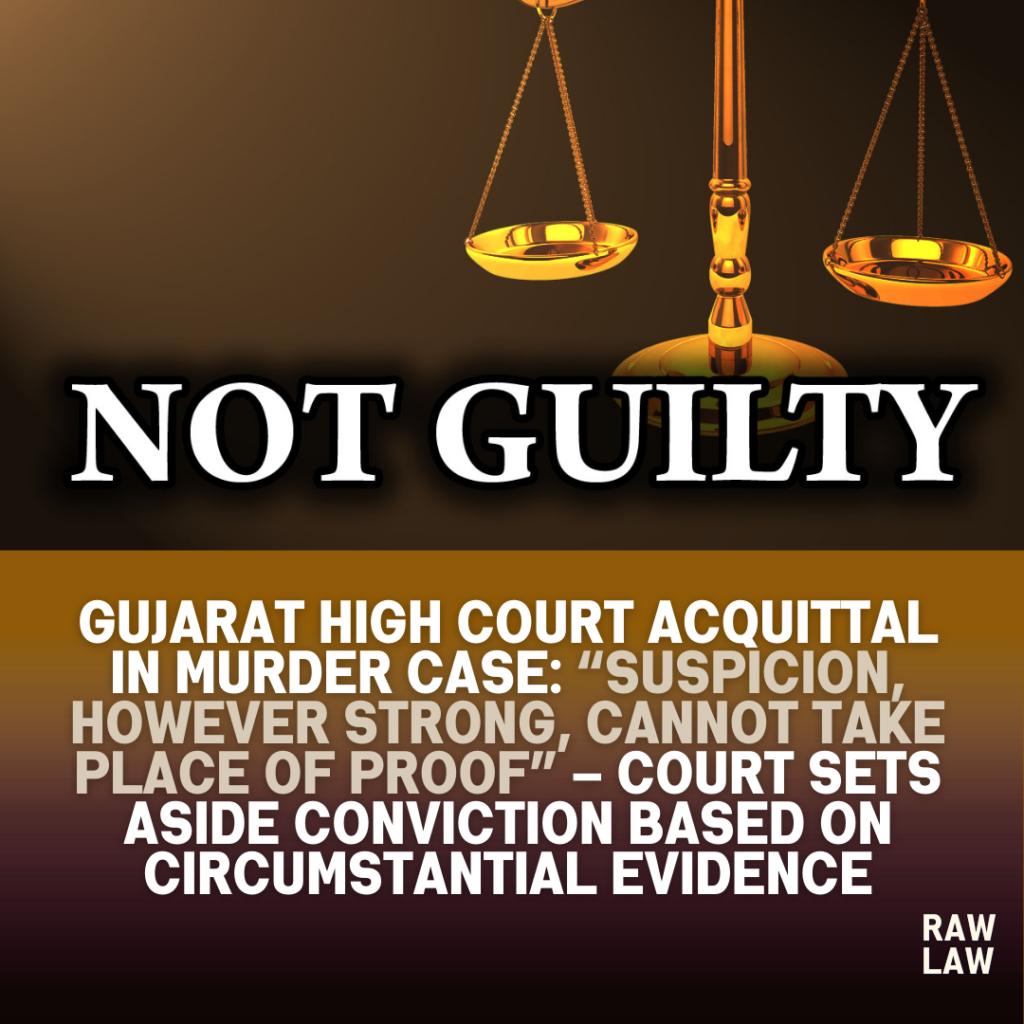Court’s Decision
The Gujarat High Court overturned the trial court’s conviction in a murder case, holding that the prosecution had failed to prove guilt beyond reasonable doubt. The Court emphasized that “suspicion, however strong, cannot take the place of proof” and reiterated that when a case rests on circumstantial evidence, each link in the chain must be fully established and point unerringly towards the guilt of the accused. Since the prosecution failed to discharge this burden, the conviction and sentence were quashed, and the accused was acquitted.
Facts
The case arose out of allegations that the accused had murdered a woman in a village setting. The prosecution relied entirely on circumstantial evidence, including recovery of ornaments, the alleged motive arising from financial disputes, and last seen theory. The trial court convicted the accused under Sections 302 and 201 of the Indian Penal Code. On appeal, the accused challenged the conviction, arguing that the evidence was weak, contradictory, and insufficient to sustain a finding of guilt.
Issues
- Whether the circumstantial evidence adduced by the prosecution formed a complete chain leading only to the conclusion of the accused’s guilt.
- Whether recovery of ornaments and other material objects could be relied upon to sustain conviction.
- Whether the trial court erred in convicting the accused despite gaps and inconsistencies in the prosecution’s case.
Petitioner’s Arguments
The appellant-accused argued that the prosecution case was entirely circumstantial and lacked direct evidence. It was contended that the alleged recovery of ornaments was doubtful and improperly proved. The defense argued that the motive was not established, that the “last seen” theory was not supported by reliable witnesses, and that the chain of circumstances was incomplete. The appellant urged that the trial court had erred in treating suspicion as proof and convicting despite reasonable doubt.
Respondent’s Arguments
The State opposed the appeal, arguing that the recovery of ornaments belonging to the deceased from the possession of the accused was a strong circumstance pointing to guilt. It was further submitted that the accused was last seen in the company of the deceased and that motive arising from prior disputes was sufficient to establish the case. The prosecution argued that taken together, these circumstances proved the guilt of the accused beyond reasonable doubt.
Analysis of the Law
The Court examined the settled law on circumstantial evidence. It reiterated that conviction can only be based on a complete chain of circumstances that excludes every hypothesis except guilt. Reliance was placed on the principle that recovery evidence must be reliable and corroborated. The Court held that in the present case, the recovery was doubtful, the motive was weak, and the “last seen” circumstance was not proved with certainty. Thus, the legal standard required for conviction was not satisfied.
Precedent Analysis
The Court referred to several landmark judgments:
- Sharad Birdhichand Sarda v. State of Maharashtra – laying down the five golden principles of circumstantial evidence (panchsheel).
- Hanumant Govind Nargundkar v. State of Madhya Pradesh – holding that each circumstance must be consistent only with guilt.
- Kali Ram v. State of Himachal Pradesh – reiterating that benefit of doubt must always go to the accused.
These precedents were applied to highlight that the prosecution had failed to meet the strict standards required for circumstantial evidence cases.
Court’s Reasoning
The Court reasoned that while suspicion was raised, the evidence fell short of proving guilt. The recovery of ornaments was not conclusively established as belonging to the deceased, the “last seen” theory lacked credible witnesses, and the alleged motive was speculative. The Court stressed: “When two views are possible, the one favouring the accused must be adopted. Courts cannot convict on mere conjectures and suspicion.”
The High Court found that the trial court had erred in overlooking these gaps and in convicting solely on suspicion.
Conclusion
The High Court set aside the conviction and acquitted the accused. It reaffirmed that criminal law requires proof beyond reasonable doubt and that suspicion cannot replace proof. The judgment restored the presumption of innocence in favour of the accused.
Implications
This judgment reinforces the high standard of proof required in criminal trials, particularly in cases based on circumstantial evidence. It serves as a reminder to lower courts that mere suspicion, recovery evidence without certainty, or weak motive cannot sustain conviction. It underscores the constitutional principle that the benefit of doubt must always go to the accused, thereby safeguarding against wrongful convictions.
Referred Cases and Their Relevance
- Sharad Birdhichand Sarda v. State of Maharashtra – Applied to outline the five golden principles of circumstantial evidence, which were found not satisfied in this case.
- Hanumant Govind Nargundkar v. State of Madhya Pradesh – Cited to stress that each link in the chain of circumstances must be proven, which was missing here.
- Kali Ram v. State of Himachal Pradesh – Referred to highlight the importance of giving the accused the benefit of doubt.
FAQs
Q1. What did the Gujarat High Court hold about circumstantial evidence in this case?
The Court held that circumstantial evidence must form a complete and unbroken chain pointing only to the guilt of the accused. Since the prosecution failed to meet this standard, the conviction was set aside.
Q2. Why was the conviction overturned despite recovery of ornaments?
The recovery was found doubtful and not conclusively linked to the deceased. Without corroboration, recovery alone could not sustain conviction.
Q3. What is the significance of this judgment?
The judgment reiterates that “suspicion, however strong, cannot take the place of proof” and ensures protection against wrongful conviction in cases based solely on circumstantial evidence.
